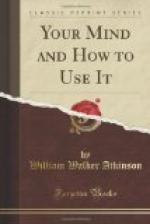We shall be better able to discuss attention if we select for analysis a concrete situation when the mind is in a state of concentrated attention. Concentrate for a moment upon the letter O. Although you are ostensibly focussing all your powers of attention upon the letter, nevertheless you are really aware of a number of things besides: of other words on the page; of other objects in the field of vision; of sounds in the room and on the street; of sensations from your clothing; and of sensations from your bodily organs, such as the heart and lungs. In addition to these sensations, you will find, if you introspect carefully enough, that your mind also contains a number of ideas and imaginings; thoughts about the paragraph you just read or about one of your lessons. Thus we see that at a time when we apparently focus our attention upon but one thing, we really have a large number of things in our mind, and they are of a great variety. The mental field might be represented by a circle, at the centre of which is the object of attention. It may be an object in the external world perceived through one of the senses, or it may be an idea we are thinking about, such, for example, as the idea of infinity. But whether the thing attended to is a perception or an idea, we may properly speak of it as the object of attention or the “focal” object. In addition to this, we must recognize the presence of a large number of other objects, both sensory and ideational. These are nearer the margin of the mental field, so we call them “marginal.”
The distinctive thing about a state of mind such as that just described is that the focal object is much clearer than the marginal objects. For example, when you fixated the letter O, it was only in the vaguest sort of fashion that you were aware of the contact of your clothing or the lurking ideas of other lessons. As we examine these marginal objects further, we find that they are continually seeking to crowd into the centre of attention and to become clear. You may be helped in forming a vivid picture of conditions if you think of the mind as a stream ever in motion, and as it flows on, the objects in it continually shift their positions. A cross-section of the stream at any moment may show the contents of the mind arranged in a particular pattern, but at the very next moment they may be arranged in a different pattern, another object occupying the focus, while the previous tenant is pushed to the margin. Thus we see that it




